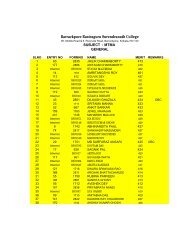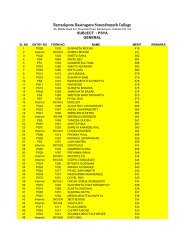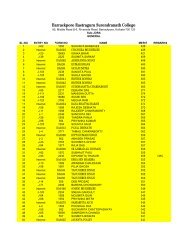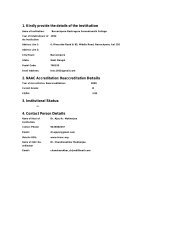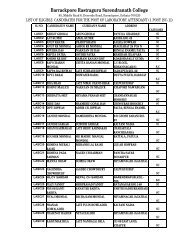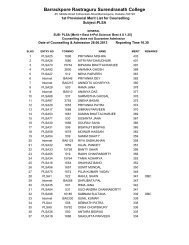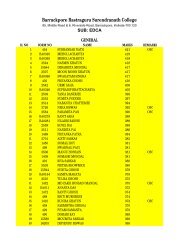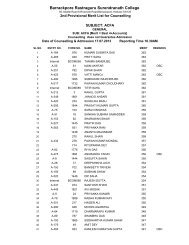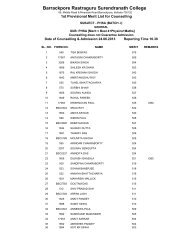Determinants of Working Capital: An Empirical Inquest with ...
Determinants of Working Capital: An Empirical Inquest with ...
Determinants of Working Capital: An Empirical Inquest with ...
You also want an ePaper? Increase the reach of your titles
YUMPU automatically turns print PDFs into web optimized ePapers that Google loves.
Journal <strong>of</strong>Business and Economic IssuesVol. 3 No. 2Received: June 2011Accepted After Review: February 2012<strong>Determinants</strong> <strong>of</strong> <strong>Working</strong> <strong>Capital</strong>:<strong>An</strong> <strong>Empirical</strong> <strong>Inquest</strong> <strong>with</strong> reference to SomeSelected Public Sector Companies in IndiaPranam Dhar and Kasturi Paul ABSTRACT: The corporate finance literature has traditionally focused on the study <strong>of</strong>long-term financial decisions, particularly investments, capital structure, dividends orcompany valuation decisions. However, short-term assets and liabilities are importantcomponents <strong>of</strong> total assets and needs to be carefully analyzed. Management <strong>of</strong> these shorttermassets and liabilities warrants careful investigation since the working capital managementplays an important role for the firm’s pr<strong>of</strong>itability and risk as well as its value. Efficientmanagement <strong>of</strong> working capital is a fundamental part <strong>of</strong> the overall corporate strategy tocreate the shareholders’ value. Firms try to keep an optimal level <strong>of</strong> working capital thatmaximizes their value. In general, from the perspective <strong>of</strong> Chief Financial Officer (CFO),<strong>Working</strong> capital management is simple and a straightforward concept <strong>of</strong> ensuring the ability<strong>of</strong> the organization to fund the difference between the short term assets and short termliabilities. In practice, working capital management has become one <strong>of</strong> the most importantissues in the organizations where many financial executives are struggling to identify the basicworking capital drivers and the appropriate level <strong>of</strong> working capital (Lamberson 1995).Consequently, companies can minimize risk and improve the overall performance byunderstanding the role and drivers <strong>of</strong> working capital. A firm may adopt an aggressiveworking capital management policy <strong>with</strong> a low level <strong>of</strong> current assets as percentage <strong>of</strong> totalassets or it may use high level <strong>of</strong> current liabilities as percentage <strong>of</strong> total liabilities. Excessivelevels <strong>of</strong> current assets may have negative effect on the firm’s pr<strong>of</strong>itability whereas a low Reader, Department <strong>of</strong> Commerce & Management, West Bengal State University, Barasat, India.E-mail: Student, PG Department <strong>of</strong> Commerce, Bhairab Ganguly College, Kolkata
Journal <strong>of</strong> Business and Economic IssuesREFERENCESAbdul Rahman, R., and Mohamed Ali, F. H. (2006). Board, Audit Committee, Culture and EarningsManagement: Malaysian Evidence. Managerial Auditing Journal, 21 (7), 783-804.<strong>An</strong>and, M., and Gupta, C. P. (2001). <strong>Working</strong> <strong>Capital</strong> Performance <strong>of</strong> Corporate India: <strong>An</strong> <strong>Empirical</strong>Survey for the Year 2000-2001. Management and Accounting Research, 4 (4), 35-65.Auerbach, C. F., and Silverstein, L. B. (2003). Qualitative Data: <strong>An</strong> Introduction to Coding and <strong>An</strong>alysis.New York, NY: New York University Press.Belt, B., and Keith V. S. (1991). Comparison <strong>of</strong> <strong>Working</strong> <strong>Capital</strong> Management Practices in Australia andthe United States. Global Finance Journal, 2, 27-54.Burns, R., and Joe, W. (1991). A Survey <strong>of</strong> <strong>Working</strong> <strong>Capital</strong> Policy among Small Manufacturing Firms.Journal <strong>of</strong> Small Business Finance, 1 (1), 61-74.Bacani, C. (2007). The big squeeze. Retrieved August 2, 2008 fromhttp://www.cfoasia.com/archives/200709-09.htmBaker, K. R., and Damon, W. W. (1977). A Simultaneous Planning Model for Production and <strong>Working</strong><strong>Capital</strong>. Decision Sciences, 8 (1), 95-108.Bartezzaghi, E., Turco, F., and Spina, G. (1992). The Impact <strong>of</strong> the Just-In-Time Approach on ProductionSystem Performance: A Survey <strong>of</strong> Italian Industry. International Journal <strong>of</strong> Operations &Production Management, 12 (1), 5-18.Bazeley, P. (2007). Qualitative Data <strong>An</strong>alysis <strong>with</strong> NVivo. Los <strong>An</strong>geles, CA: Sage.Ben-Horim, M., and Levy, H. (1983). Management <strong>of</strong> Accounts Receivable under Inflation. FinancialManagement, 12 (1), 42-48.Beranek, W. (1963). <strong>An</strong>alysis for Financial Decisions. Homewood, IL: R.D. Irwin, Inc.Beranek, W. (1967). Financial Implications <strong>of</strong> Lot-size Inventory Models. Management Science, 13 (8),B401-B408.Berry, A., and Otley, D. (2004). Case-based Research in Accounting. In C. Humphrey & B. Lee (Eds.),The Real Life Guide to Accounting Research: A Behind-the-Scenes View <strong>of</strong> Using QualitativeResearch Methods, Boston, MA: Elsevier, 231-256.Bielenberg, C. (1992). Winning the Customer Service War. Managing Service Quality, 3 (1), 411-416.Bierman, H., Chopra, K., and Thomas, J. (1975). Ruin Considerations - Optimal <strong>Working</strong> <strong>Capital</strong> and<strong>Capital</strong> Structure. Journal <strong>of</strong> Financial and Quantitative <strong>An</strong>alysis, 10 (1), 119-128.Carey, J. L. (1949). Corporation <strong>Working</strong> <strong>Capital</strong> Increases. Journal <strong>of</strong> Accountancy, 87 (6), 459-460.Chen, K. H., and Thomas, A. S. (1981). <strong>An</strong> <strong>Empirical</strong> <strong>An</strong>alysis <strong>of</strong> Useful Financial Ratios. FinancialManagement 10 (1), 51-60.Chu, David K.W., Terrell W. Zollinger, <strong>An</strong>ne S. Kelly and Robert M. Saywell, Jr, “<strong>An</strong> <strong>Empirical</strong> <strong>An</strong>alysisOf Cash Flow, <strong>Working</strong> <strong>Capital</strong>, <strong>An</strong>d The Stability Of Financial Ratio Groups In The HospitalIndustry,” Journal <strong>of</strong> Accounting and Public Policy 10 (1), pp. 39-58.
Dhar & Paul - <strong>Determinants</strong> <strong>of</strong> <strong>Working</strong> <strong>Capital</strong>: <strong>An</strong> <strong>Empirical</strong> <strong>Inquest</strong> …Cheatham, L., & Cheatham, C. (1993). Utilizing financial statements as cash flow planning and controltools. Managerial Finance, 19(8), 35-49.Claessens, S., Djankov, S., & Xu, L. C. (2000). Corporate performance in the East Asian financial crisis.The World Bank Research Observer, 15(1), 23-46.Cocheo, S. (2004). "Bring us your rejects" or "factoring for pr<strong>of</strong>itability". American Bankers Association.ABA Banking Journal, 96(6), 16-18.Cooper, D. R., & Schindler, P. S. (2006). Business research methods (9th ed.). Boston, MA: McGraw-HillIrwin.Crane, S. (2001). The great cash hunt. Retrieved Aug 15, 2008 fromhttp://www.cfoasia.com/archives/200102-28.htmCrum, R. L., Klingman, D. D., & Tavis, L. A. (1983). <strong>An</strong> operational approach to integrated workingcapital planning. Journal <strong>of</strong> Economics and Business, 35(3,4), 343-378.Damon, W. W., & Schramm, R. (1972). A simultaneous decision model for production, marketing andfinance. Management Science 19(2), 161-172.De<strong>An</strong>gelo, H., De<strong>An</strong>gelo, L. E., & Wruck, K. H. (2001). Asset liquidity, debt covenants, and managerialdiscretion in financial distress : the collapse <strong>of</strong> L.A. Gear. Columbus, OH: Max M. Fisher College<strong>of</strong> Business, Ohio State University.Delo<strong>of</strong>, M. (2003). Does working capital management affect pr<strong>of</strong>itability <strong>of</strong> Belgian firms? Journal <strong>of</strong>Business Finance & Accounting, 30(3/4), 573-588.DeLorenzo, G. J. (2002). Decision support system model to reduce working capital when usingapplication service providers. Unpublished D.Sc., Robert Morris University, Pennsylvania, UnitedStates.Edwards, J. R., Wagner, H. M., & Wood, W. P. (1985). Blue Bell trims its inventory. Interfaces, 15(1), 34-52.Eisenhardt, K. M. (1989). Building theories from case study research. The Academy <strong>of</strong> ManagementReview, 14(4), 532-550.Eisenhardt, K. M., & Graebner, M. E. (2007). Theory building from cases: opportunities and challenges.Academy <strong>of</strong> Management Journal, 50(1), 25-32.Emery, D. R., Finnerty, J. D., & Stowe, J. (2004). Corporate financial management. Upper Saddle River,NJ: Prentice Hall.Evans, G. N., Naim, M. M., & Towill, D. R. (1993). Dynamic supply chain performance: Assessing theimpact <strong>of</strong> information systems. Logistics Information Management,6(4), 15-25.Ferconio, Sandra and Michael R. Lane, “Financing Maneuvers: Two Ways to Boost <strong>Working</strong> <strong>Capital</strong>,”Healthcare Financial Management 5 (10), 1991, pp. 74-80.Frecka, Thomas J. and Cheng F. Lee, “Generalized Financial Ratio Adjustment Processes <strong>An</strong>d TheirImplications,” Journal<strong>of</strong> Accounting Research 21 (1), 1983, pp. 308-316.Fairchild, A. (2005). Intelligent matching: integrating efficiencies in the financial supply chain. SupplyChain Management, 10(4), 244-248.
Journal <strong>of</strong> Business and Economic IssuesFilbeck, G., Krueger, T., & Preece, D. (2007). CFO magazine's working capital surveys: do selected firmswork for shareholders? Quarterly Journal <strong>of</strong> Business and Economics, 46(2), 3-22.Filbeck, G., & Krueger, T. M. (2005). <strong>An</strong> analysis <strong>of</strong> working capital management results acrossindustries. Mid American Journal <strong>of</strong> Business, 20(2), 11-18.Fredenberger, W. B., DeThomas, A., & Ray, H. N. (1993). Information needs <strong>of</strong> firms in financial distress.International Journal <strong>of</strong> Information Management, 13(5), 326-330.Gitman, Lawrence J, Principles <strong>of</strong> Managerial Finance, 7th Ed. Harper Collins, pp. 646-652.Gombola, Michael J. and J. Edward Ketz, “Financial Ratio Patterns In Retail <strong>An</strong>d ManufacturingOrganizations,” Financial Management 12 (2), 1983, pp. 45-56.Gupta, Manak C, “The Effect <strong>of</strong> Size, Growth, and Industry On The Financial Structure OfManufacturing Companies, Journal <strong>of</strong> Finance 24 (3), 1969, pp. 517-529.Gupta, Manak C. and Ronald J. Huefner, “A Cluster <strong>An</strong>alysis Study Of Financial Ratios and IndustryCharacteristics,” Journal <strong>of</strong> Accounting Research 10 (1), 1972, pp. 77-95.García-Teruel, P. J., & Martínez-Solano, P. (2007). Effects <strong>of</strong> working capital management on SMEpr<strong>of</strong>itability. International Journal <strong>of</strong> Managerial Finance, 3(2), 164-186.Gitman, L. J. (2009). Principles <strong>of</strong> managerial finance (12th ed.). Boston, MA: Pearson Prentice Hall.Hadley, G. (1964). A comparison <strong>of</strong> order quantities computed using the average annual cost and thediscounted cost. Management Science, 10(3), 472-476.Hadley, L. (2006). International working capital management. The Business Review Cambridge, 5(1),233-239.Haley, C. W., & Higgins, R. C. (1973). Inventory policy and trade credit financing. Management Science,20(4), 464-471.Hampton, J. J., & Wagner, C. L. (1989). <strong>Working</strong> capital management. New York, NY: Wiley.Hartley, J. (2004). Case study research. In C. Cassell & G. Symon (Eds.), Essential guide to qualitativemethods in organizational research (pp. 323-333). Thousand Oaks, CA: Sage Publications.Hawawini, G., Viallet, C., & Vora, A. (1986). Industry influence on corporate working capital decisions.Sloan Management Review, 27(4), 15-25.Herbst, A. F. (1974). Some empirical evidence on the determinants <strong>of</strong> trade credit at the industry level <strong>of</strong>aggregation. Journal <strong>of</strong> Financial and Quantitative <strong>An</strong>alysis, 9(3), 357-394.Hill, N. C., & Sartoris, W. L. (1992). Short-term financial management: text and cases (2 nd ed.). NewYork, NY: Maxwell Macmillan International.Holdren, D. P., & Hollingshead, C. A. (1999). Differential pricing <strong>of</strong> industrial services: the case <strong>of</strong>inventory financing. Journal <strong>of</strong> Business and Industrial Marketing, 14(1), 7-Hossain, S. Z., & Akon, M. H. R. (1997). Financing <strong>of</strong> working capital: case study <strong>of</strong> Bangladesh textilemills corporation. Journal <strong>of</strong> Financial Management & <strong>An</strong>alysis, 10(2), 37-42.Johnson, Craig G., “Ratio <strong>An</strong>alysis <strong>An</strong>d The Prediction Of Firm Failure: Comment,” Journal <strong>of</strong> Finance25 (5), 1970, pp. 1166-1168.
Dhar & Paul - <strong>Determinants</strong> <strong>of</strong> <strong>Working</strong> <strong>Capital</strong>: <strong>An</strong> <strong>Empirical</strong> <strong>Inquest</strong> …Jaiswal, M. P., & Kaushik, A. (2005). Realising enhanced value due to business network redesign throughextended erp systems: case study <strong>of</strong> HLLNet. Business Process Management Journal, 11(2), 171-184.Johnson, R., & Soenen, L. (2003). Indicators <strong>of</strong> successful companies. European Management Journal,21(3), 364-369.Kim, Suk H., Martha Rowland and Seung H. Kim, “<strong>Working</strong> <strong>Capital</strong> Practices By Japanese ManufacturersIn The U.S.,” Financial Practice and Education 2 (1), 1992, pp. 89-92.Kincaid, Timothy J., “Selling Accounts Receivable To Fund <strong>Working</strong> <strong>Capital</strong>,” Healthcare FinancialManagement 7 (5), 1993, pp. 26-32.Ketchum, M. D. (1942). <strong>Working</strong>-capital financing in a war economy. The Journal <strong>of</strong> Business <strong>of</strong> theUniversity <strong>of</strong> Chicago, 15(4), 306-343.Ketchum, M. D. (1943). Plan financing in a war economy. The Journal <strong>of</strong> Business <strong>of</strong> the University <strong>of</strong>Chicago, 16(1), 28-51.Kim, Y. H., & Chung, K. H. (1990). <strong>An</strong> integrated evaluation <strong>of</strong> investment in inventory and credit: acash flow approach. Journal <strong>of</strong> Business Finance & Accounting, 17(3), 381- 390.Knight, W. (1972). <strong>Working</strong> capital management satisficing versus optimization. Financial Management1(1), 33-40.Kolay, M. K. (1991). Managing working capital crises: a system dynamics approach. ManagementDecision, 29(5), 46-52.Krishna, K. R., Dmitri, G., & Victor, P. S. (1993). Earnings, cash flows and executive compensation: anexploratory analysis. Managerial Finance, 19(2), 55-75.Lazaridis, I., & Tryfonidis, D. (2006). Relationship between working capital management andpr<strong>of</strong>itability <strong>of</strong> listed companies in the Athens Stock Exchange. Journal <strong>of</strong> financial managementand analysis, 19(1), 26-35.Lo, N. (2005). Go <strong>with</strong> the flow. Retrieved August 14, 2008 fromhttp://www.cfoasia.com/archives/200503-02.htmLoeser, D. (1988). Improving accounts receivable management. Journal <strong>of</strong> Accountancy, 166(5), 116-117.L<strong>of</strong>land, J., Snow, D. A., <strong>An</strong>derson, L., & L<strong>of</strong>land, L. H. (2006). <strong>An</strong>alyzing social settings: a guide toqualitative observation and analysis (4th ed.). Belmont, CA: Wadsworth/Thomson Learning.Moyer, McGuigan and Kretlow, Contemporary Financial Management, 6th Ed. West Publishing, pp.603-613.Maness, T. S. (1994). The cash-flow timeline and the credit manager. Business Credit, 96(7), 10-12.McInnes, A. N. S. (2000). <strong>Working</strong> capital management : theory and evidence from New Zealand listedlimited liability companies: a thesis submitted in partial fulfilment <strong>of</strong> the requirements for thedegree <strong>of</strong> master <strong>of</strong> commerce and management at Lincoln University. Unpublished Thesis (M CM ), Lincoln University, Lincoln, New Zealand.McMahon, R. G. P., & Holmes, S. (1991). Small business financial management practices in NorthAmerica: a literature review. Journal <strong>of</strong> Small Business Management, 29(2), 19-29.
Journal <strong>of</strong> Business and Economic IssuesNunn, Kenneth P. Jr, “The Strategic <strong>Determinants</strong> Of <strong>Working</strong> <strong>Capital</strong>: A Product-Line Perspective,”Journal <strong>of</strong> Financial Research 4 (3), 1981, pp. 207-219.Ooghe, H. (1998). Financial management practices in China: a case study approach to companies in theShanghai region. European Business Review, 98(4), 217-226.Pinches, George E, Essentials <strong>of</strong> Financial Management, 4th Ed. Harper Collins Publishing.Pinches, George E., Kent A. Mingo and J. Kent Caruthers, “The Stability Of Financial Patterns InIndustrial Organizations,” Journal <strong>of</strong> Finance 28 (2), 1973, pp. 389-396.Peel, M. J., Wilson, N., & Howorth, C. (2000). Late payment and credit management in the small firmsector: some empirical evidence. International Small Business Journal, 18(2), 17-37.Rafuse, M. E. (1996). <strong>Working</strong> capital management: an urgent need to refocus. Management Decision,34(2), 59-63.Raman, A., & Kim, B. (2002). Quantifying the impact <strong>of</strong> inventory holding cost and reactive capacity onan apparel manufacturer's pr<strong>of</strong>itability. Production and Operations Management, 11(3), 358-363.Reason, T. (2008). Preparing your company for recession. Retrieved August 2, 2008 fromhttp://ezproxy.lincoln.ac.nz/login?url=http://proquest.umi.com/pqdweb?did=1423329071&Fmt=7&clientId=18963&RQT=309&VName=PQDReyman, G. (2005). How Johnsondiversey implemented s&op in Europe. Journal <strong>of</strong> Business ForecastingMethods and Systems, 24(3), 20-28.Richards, V. D., & Laughlin, E. J. (1980). A cash conversion cycle approach to liquidity analysis. FinancialManagement, 9(1), 32-38.Sartoris, W. L., Hill, N. C., & Kallberg, J. G. (1983). A Generalized Cash Flow Approach to Short-TermFinancial Decisions/Discussion. The Journal <strong>of</strong> Finance, 38(2), 349-360.Sathyamoorthi, C. R. (2002). Management <strong>of</strong> working capital in selected co-operatives in Botswana.Finance India, 16(3), 1015-1044.Scapens, R. W. (2004). Doing case study research. In C. Humphrey & B. Lee (Eds.), The real life guide toaccounting research: a behind-the-scenes view <strong>of</strong> using qualitative research methods (pp. 257-280). Boston, MA: Elsevier.Scherr, F. C. (1989). Modern working capital management: text and cases. Englewood Cliffs, NJ: PrenticeHall.Schilling, G. (1996). <strong>Working</strong> capital's role in maintaining corporate liquidity. TMA Journal, 16(5), 4-7.Sehgal, S., Sahay, B. S., & Goyal, S. K. (2006). Reengineering the supply chain in a paint company.International Journal <strong>of</strong> Productivity and Performance Management, 55(8), 655-670.Seidner, A. G. (1990). Investing excess working capital. Management Accounting, 71(9), 24-27.Shapiro, A. (1973). Optimal inventory and credit-granting strategies under inflation and devaluation.Journal <strong>of</strong> Financial and Quantitative <strong>An</strong>alysis, 7(1), 37-46.Shulman, J. M., & Cox, R. A. K. (1985). <strong>An</strong> integrative approach to working capital management. Journal<strong>of</strong> Cash Management, 5(6), 64-67.
Dhar & Paul - <strong>Determinants</strong> <strong>of</strong> <strong>Working</strong> <strong>Capital</strong>: <strong>An</strong> <strong>Empirical</strong> <strong>Inquest</strong> …Srivastava, S. (2004). Using six sigma methodologies to optimize working capital management. CorporateFinance Review, 9(1), 29-37.Strischek, D. (2001). A banker's perspective on working capital and cash flow management. StrategicFinance, 83(4), 38-45.Thompson, R. (1986). Understanding cash flow: a system dynamics analysis. Journal <strong>of</strong> Small BusinessManagement, 24(2), 23-30.Trahan, E. A., & Gitman, L. J. (1995). Bridging the theory-practice gap in corporate finance: a survey <strong>of</strong>chief financial <strong>of</strong>ficers. Quarterly Review <strong>of</strong> Economics and Finance, 35(1), 73-87.Vander Weide, J. H., & Maier, S. F. (1985). Managing corporate liquidity: an introduction to workingcapital management. New York, NY: Wiley.Wadhwa, S., Kanda, A., Bhoon, K. S., & Bibhushan. (2006). Impact <strong>of</strong> supply chain collaboration oncustomer service level and working capital. Global Journal <strong>of</strong> Flexible Systems Management,7(1/2), 27-35.Walia, T. S. (1977). Explicit and implicit cost <strong>of</strong> changes in the level <strong>of</strong> accounts receivable and the creditpolicy decision <strong>of</strong> the firm. Financial Management, 6(4), 75-78.Wood, A. (1993). Efficient consumer response. Logistics Information Management, 6(4), 38-40.Yang, G., Ronald, R. J., & Chu, P. (2005). Inventory models <strong>with</strong> variable lead time and present value.European Journal <strong>of</strong> Operational Research, 164(2), 358-366.Yin, R. K. (1994). Case study research: design and methods (2nd ed.). Thousand Oaks, CA: SagePublications.Yin, R. K. (2003). Case study research: design and methods (3rd ed.). Thousand Oaks, CA: SagePublications.



